- Conditions
- Procedures
- Patient care
- Why choose us
- Our Doctors
- Contact
Home » Spine Conditions »
Collapsed disc overview

A collapsed disc is a spinal disc that has lost its normal height due to deterioration of its fibrous outer wall. While this degeneration can be related to traumatic injury, it is more frequently a result of wear due to the natural aging process. Diminished disc height is most common within the cervical (upper) and lumbar (lower) regions of the spine, where the vertebrae bear significant body weight and are subjected to a wide range of stress-inducing motion. A collapsed disc does not necessarily produce symptoms, but if reduced disc height leads to compression of a nerve root or the spinal cord, pain, tingling, numbness or muscle weakness can occur.
The anatomy of a collapsed disc
The discs are natural shock absorbers between the vertebrae in the spinal column. Discs have two main components, a tougher outer layer and a gelatinous core. When axial loading pressure occurs along the spinal column, the core of the disc squeezes outward against the outer layer of the disc. The elasticity of the outer wall pushes the core back into position, reestablishing the height and shape of the disc. Through the years as a person ages, normal daily activity causes repeated loading of the disc. Tiny rips may develop in the fibers of the disc wall causing a loss of natural elasticity.
Eventually, the outer disc wall can no longer push the center material back into shape as effectively, which can lead to bulges and a loss of height. The main way a collapsed disc produces pain and other symptoms is by reducing the space available for spinal nerves. Less space means a greater likelihood of nerve compression. In addition, the decreased disc height reduces the ability of the disc to act as a cushion between vertebrae, creating the potential for bone to rub against bone causing development of bone spurs. These bone spurs may also irritate or compress nerves in the spinal column as well.
Treating the symptoms of a collapsed disc
While disc degeneration is irreversible, resulting symptoms can often be treated successfully using pain medication, epidural steroid injections, exercise and other nonsurgical methods. However, if chronic pain or other nerve compression symptoms persist after several weeks of conservative treatment and surgery does become an option, contact USA Spine Care. Our minimally invasive spine surgery is performed on an outpatient basis, leading to a reduced risk of complication and no lengthy recovery compared to traditional open neck or back surgery.
Reach out to our dedicated team today for a no-cost MRI review* to determine if you are a potential candidate for one of our procedures.
